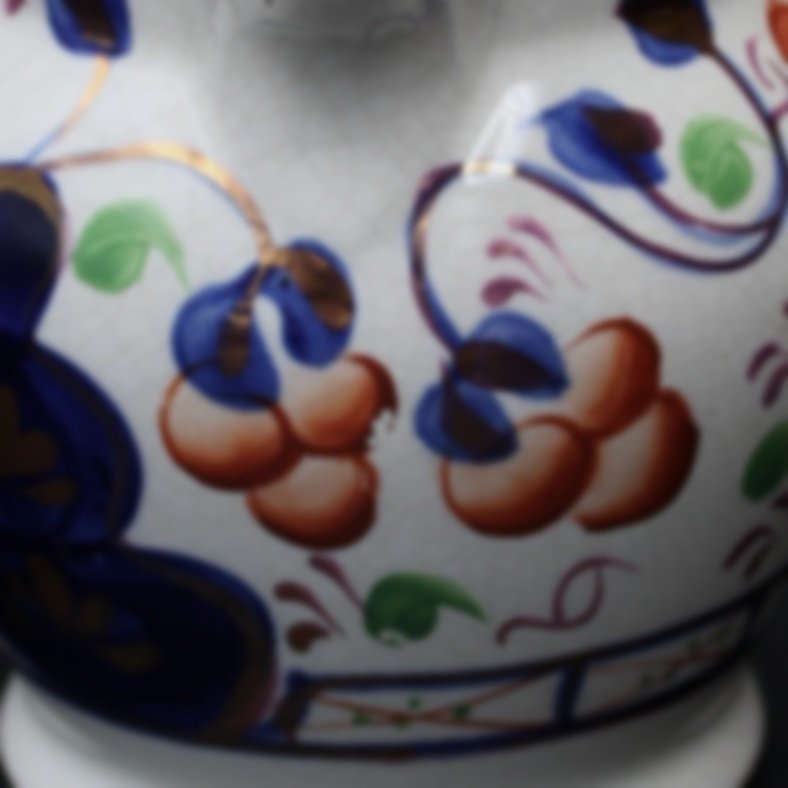
Gaudy Welsh
Cheap, cheerful, and contradictory: hand-painted, mass-produced ceramics
Gaudy Welsh ceramics are both handmade Welsh goods and mass-produced products with international influences.
This ware was inspired by Japanese ceramics, made and sold in Britain, and exported and collected in America - while remaining a significant part of Welsh culture.
These pieces come from Jean Shields’ collection.
Various Gaudy Welsh pieces. Shown in further detail and identified down below.
Despite their name, they were not exclusively Welsh. These ceramics were made in Britain between 1820 and 1860 and sold in Britain and North America. They were affordable to working-class people with little disposable income.
Their painted decoration was done by women and children.
Gaudy Welsh was cheaply made for working-class people.
Cream pitcher with Gaudy Welsh ‘Oyster’ pattern. Britain, 1820-1860. 12 cm tall. 1994.1.70
These colourful pieces represent a transition between handmade and industrially-produced ceramics.
Gaudy Welsh pieces vary significantly. They are made in a variety of colours, patterns, and qualities, and are painted by hand.
Gaudy Welsh is made in a limited range of colours, to minimize the number of firings needed. This strategy saved time but made these wares to wear.
All the colours used, save for the cobalt blue underglaze, are applied over the glaze, and are not protected by it. Because the coloured enamel overglazes and the shiny copper lustre are not protected by the glaze, they can wear off over time.
Over time, designs and colour schemes were simplified even more to facilitate even easier decoration.
Side Profile
Small mug with Gaudy Welsh ‘Geranium’ (?) pattern. Britain, 1820-1860. 8 cm tall. 1994.1.73
Front Profile
Small mug with Gaudy Welsh ‘Geranium’ (?) pattern. Britain, 1820-1860. 8 cm tall. 1994.1.73
Most of the pieces in this collection have the same colours.
Left: Detail of worn enamel on ‘Oyster’ pattern. 1994.1.68.
Right: Detail of pristine enamel on ‘Tulip’ pattern. 1994.1.71
Can you spot the rare colours? Which ones are more common?
Gaudy Welsh is a family of over 400 patterns.
Factories frequently copied each other and rarely labelled their work. Many of these patterns were named and documented by collectors. Even the name “Gaudy Welsh” was introduced by American collectors. (Welsh people call this ware “Swansea Cottage”).
Cream pitcher with Gaudy Welsh ‘Tulip’ pattern. Britain, 1820-1860. 9 cm tall. 1994.1.71
“Tulip” is one of the oldest, most common, and most popular Gaudy Welsh patterns. Many other patterns were short-lived, but Tulip was produced over the entire period. The near-pristine condition of the enamels, and the inclusion of yellow enamel, are both unusual for this collection.
The lustre on this mug has mostly worn off. Note the bright white ceramic and detailed handle.
Small mug with Gaudy Welsh ‘Grape’ (?) pattern. Britain, 1820-1860. 8 cm tall. 1994.1.72
Gaudy Welsh differs in quality and workmanship.
Ceramic bodies vary in shape and quality.
Some pieces have more complicated moulded handles, while others have simpler shapes.
The painting also varies by piece.
Some patterns are more detailed than others, while others vary in execution: sometimes you will see blue glaze “flowing,” creating blotches or blurred edges.
Note the blotches of blue glaze and very worn lustre.
Cream pitcher and slop bowl with unknown Gaudy Welsh pattern. Britain, 1820-1860. 8 cm tall. 1994.1.65 (left) and 1994.1.75 (right)
Gaudy Welsh patterns mimic Japanese art.
Gaudy Welsh patterns mimic Imari ware, a brightly-coloured style of Japanese export porcelain that has blue underglaze, overglaze enamels in colours such as red and black, and characteristic floral designs. Imari was exported to Europe in large quantities and was mimicked by many European manufacturers.
Blue Willow, which Jean also collected, has East Asian influences too.
Large pitcher with Gaudy Welsh (?) ‘Pagoda’ (?) pattern. England, 1845. 21 cm tall. 1994.1.15
This pitcher is both very different than Jean’s other Gaudy Welsh pieces, and well-matched to this part of her collection. The architectural motifs and straight structural lines contrast with the squat curves of her small cream pitchers, but the colour scheme and delicately shaded petals on the flower are typical Gaudy.
The tea plate is the only featured piece without green enamel.
Left: Tea plate with Gaudy Welsh ‘Oyster’ pattern. Britain, 1820-1860. 23.3 cm diameter. 1994.1.78. Right: Small mug with Gaudy Welsh ‘Oyster’ pattern. Britain, 1820-1860. 8 cm tall. 1994.1.74
Gaudy Welsh is associated with Welsh visual culture and Welsh women’s collecting traditions.
Welsh women displayed this ware on finely crafted dressers.
Gaudy Welsh picked up decades of symbolic meaning and memories as women passed these ceramics down to their daughters, who became the next generation of collectors and caretakers.
This ware’s popularity with immigrants seems to resonate with Jean Shields’ Scottish roots.
Jean was the granddaughter of a Scottish immigrant, and she seems to have had an affinity for British ceramics.
Welsh immigrants to America brought Gaudy Welsh ceramics with them or bought exported pieces once they arrived. Their descendants also became collectors.
Jean Shields gravitated towards cream pitchers and the Oyster pattern.
Jean likely selected these similar forms and patterns for display.
Though the enamel on some pieces is worn, it would have fared worse with regular use.
Cream pitcher with Gaudy Welsh ‘Oyster’ pattern. Britain, 1820-1860. 9.5 cm tall. 1994.1.64
This pitcher’s slim shape and textured decoration are unusual for Jean’s collection.
Three cream pitchers showing different parts of the Gaudy Welsh ‘Oyster’ pattern. Britain, 1820-1860. 10-11.5cm tall. From left: 1994.1.67, 1994.1.68, and 1994.1.69
Inherited collections prompt their caretakers to consider the lives of the women that came before them. Maintaining and refreshing these displays allows for moments of meditation.
We at the museum can consider the collectors that came before us, and how they lived their lives.
Dinner plate with Gaudy Welsh ‘Water Lily’ (?) pattern. Britain, 1820-1860. 25 cm wide. 1994.1.89






























